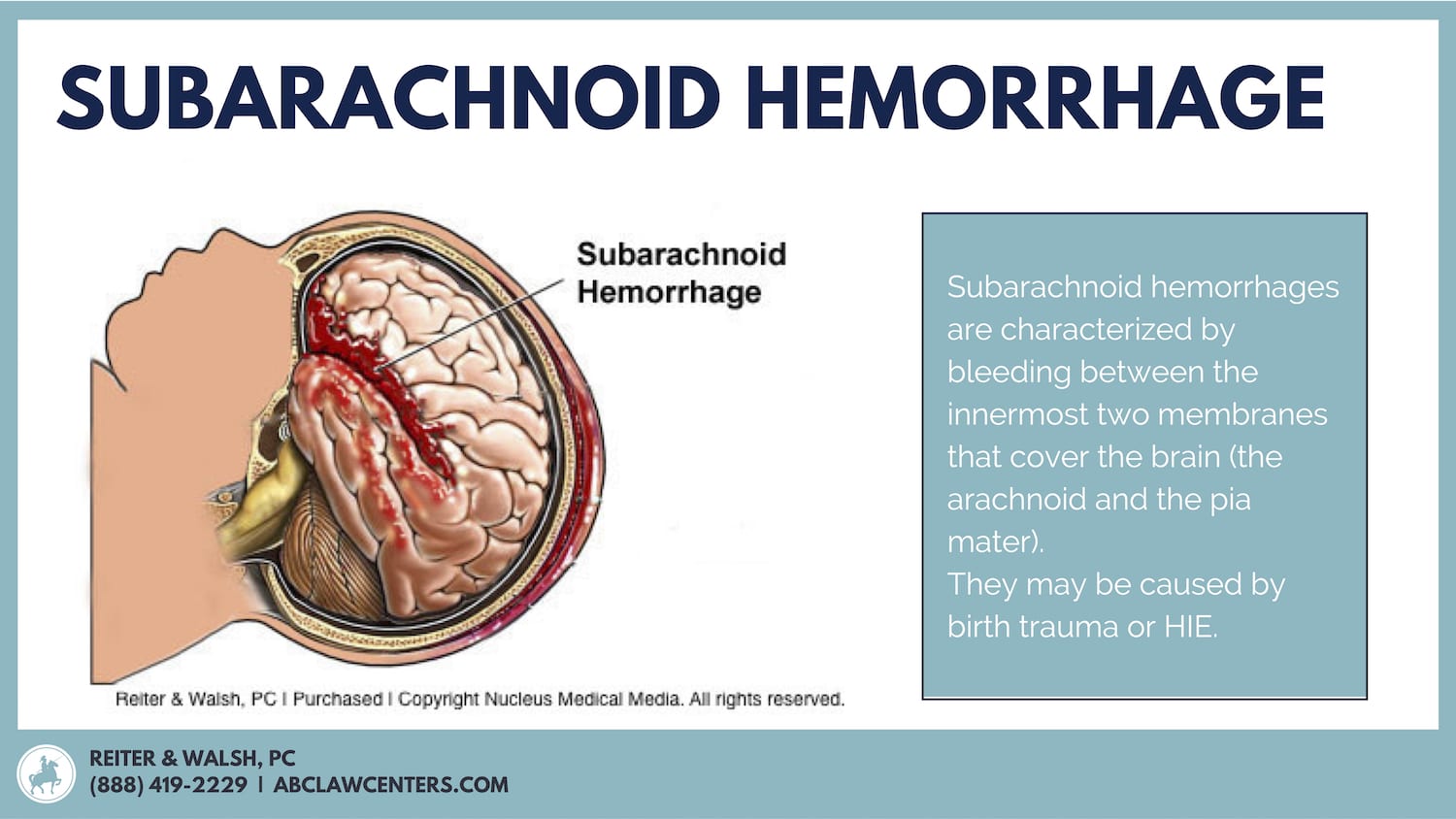Subarachnoid Hemorrhage in Newborns
A subarachnoid hemorrhage is one of the most common types of intracranial hemorrhage (brain bleed), and is characterized by the pooling of blood between the arachnoid and the pia mater. In other words, it is bleeding between the innermost two membranes that cover the brain. These hemorrhages occur when bridging blood vessels or dural sinuses rupture (1).

Causes of Subarachnoid Hemorrhage
In newborns, subarachnoid hemorrhages can result from either birth trauma (excessive mechanical force on the baby during birth) or hypoxic-ischemic injury (lack of oxygenated blood flow to the brain) (2, 3). The former is a more common cause in term infants, and the latter in preterm infants (2).
Some factors that can cause birth trauma include mismanagement of an abnormal fetal presentation, improper use of forceps or vacuum extractors, attempts to vaginally deliver babies that will not fit through the mother’s pelvis (see macrosomia and cephalopelvic disproportion), and overuse of the labor-assisting drugs Pitocin and Cytotec. Hypoxia can result from all of the same issues, as well as umbilical cord injuries, uterine rupture, placental abruption, and more. Both birth trauma and hypoxia are often avoidable, and may be caused by medical malpractice.
Signs and Symptoms of Subarachnoid Hemorrhage
Signs of a subarachnoid hemorrhage may include:
- Seizures
- Apnea: temporarily ceasing to breathe
- Bradycardia: slow heart rate (3)
- Hydrocephalus: a condition in which fluid builds up in the brain; about 20-30% of infants with subarachnoid hemorrhage develop hydrocephalus (4).
Diagnosis of Subarachnoid Hemorrhage
Subarachnoid hemorrhage can be diagnosed with a CT scan, or in non-emergency situations, an MRI (5). Treatment is generally supportive, and includes monitoring neurological signs and seizures, managing seizures, administering intravenous therapy, and preventing further hemorrhage (2). Some may require surgical intervention, such as the insertion of a shunt to treat hydrocephalus (4).
Long-Term Outcomes of Subarachnoid Hemorrhage
Research has shown that the majority of subarachnoid hemorrhages are minor, and babies usually survive without any lasting problems. Of more serious complications, the most common is posthemorrhagic hydrocephalus. Some cases of massive subarachnoid hemorrhage may result in permanent brain damage or even death (6).


Legal Help for Long-Term Outcomes of Subarachnoid Hemorrhages
Serious subarachnoid hemorrhages that go undiagnosed or are improperly treated can result in lifelong disabilities. If you believe that your child’s medical condition(s) are the result of a poorly-managed subarachnoid hemorrhage or other form of malpractice around the time of birth, the attorneys at ABC Law Centers: Birth Injury Lawyers can help.
We have the knowledge and professional experience to thoroughly examine the complex medical records of your child’s case, determine whether there was an error or negligence, and help you obtain the monetary compensation your child deserves. Free of charge and obligations, we will answer your legal questions, determine the negligent party, and inform you of your legal options. Our team is available to speak with you to set up an appointment in any of the following ways:
Featured Videos
Posterior Position
Hypoxic-Ischemic Encephalopathy (HIE)

Featured Testimonial
What Our
Clients Say…
After the traumatic birth of my son, I was left confused, afraid, and seeking answers. We needed someone we could trust and depend on. ABC Law Centers: Birth Injury Lawyers was just that.
- Michael
Helpful resources
- Perinatal intracranial hemorrhages pathology
- Wong HW, Perry L. Maternal Child Nursing Care. 2006
- Symptomatic subarachnoid hemorrhage in the term newborn
- Hydrocephalus after subarachnoid hemorrhage: pathophysiology, diagnosis, and treatment
- Neonatal birth injuries
- Volpe JJ. Neurology of the Newborn E-Book. Elsevier Health Sciences. 2008.


